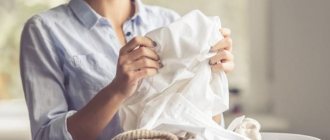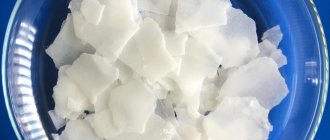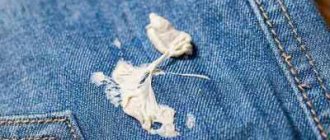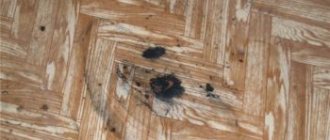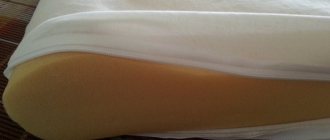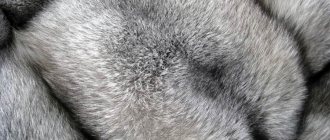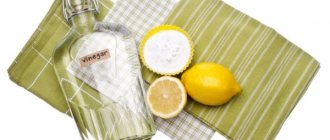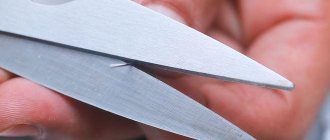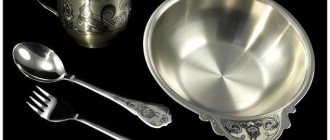Denim items are very popular among different age categories. But over time, the fabric becomes dirty and fades, which is why the wardrobe item loses its former attractiveness. Fortunately, denim can be processed in different ways - lightening, dyeing, bleaching, and creating a torn effect. This way you can give your clothes a second life. The main thing is to do all manipulations correctly and using suitable means.
Release form
The commercial sale of Whiteness is carried out in 4 forms:
- in liquid form;
- in gel form;
- in powder form;
- in tablet form.
Depending on the form of release, the cost of the product varies. The difference in release forms is based on the target function and ease of use of the product.
Liquid aqueous solution
The liquid product is used to bleach natural fiber fabrics, wash floors, and clean white porcelain and earthenware. Sold in white or translucent plastic bottles or canisters with a screw cap of 1-5 liters.
Gel consistency
The gel variety is intended for washing plumbing fixtures and enamel bathtubs. A denser structure ensures the removal of rust and stubborn stains. Available in bottles with an extended dispenser, equipped with safety caps. The container volume is 0.5-1 l.
In powder form
The powder form is characterized by the absence of chloride compounds in the composition. It is suitable for use in washing machines as an additional product. Adding Whiteness to washing powder reduces its consumption, increasing the effectiveness of stain removal. Available in cardboard and plastic boxes. The powder variety is a cheap analogue of Vanish stain remover.
Tablet
The tablet form of the product is used for washing fabrics, sanitizing surfaces and disinfecting equipment. Available in 2 versions: with and without chlorine. Without chlorine it is used as a disinfectant, with chlorine it is used exclusively as a bleach. Sold in plastic tubes with a hinged or screw cap.
How can you dye your pants black?
You can dye a product black using coffee, tobacco or hair dye: Coffee will help restore the intense black color of fabric that has lost its original appearance. To dye, you need to prepare enough instant or boiled coffee so that the liquid can cover the item being dyed.
Interesting materials:
How to take a screenshot on a Dell laptop? How to make a screenshot on a laptop DNS? How to take a screenshot on a Lenovo laptop? How to take a screenshot on an Acer laptop? How to take a screenshot on Samsung a51? How to take a screenshot on an Android smartphone? How to take a screenshot of an area of the screen? How to take a screenshot of a window? How to take a screenshot from your phone screen? How to take a screenshot from the keyboard?
Advantages and disadvantages
The popularity of Whiteness is ensured by the following advantages:
- low cost;
- high efficiency for local removal of contaminants;
- economical consumption;
- variety of commercial forms;
- wide range of uses;
- Possibility of use in cold water;
- Possibility of application to surfaces with a spray gun;
- preservation of properties after freezing.
The disadvantages of the product include:
- lack of measuring containers in the set;
- rapid consumption of non-concentrated products;
- clogging and leaking lids;
- impossibility of using colored fabrics, wool products and artificial fibers for washing;
- presence of a strong chlorine odor;
- aggressive effect on the skin of the hands and mucous membranes.
Preparing for work
To dye a T-shirt, you will need an enamel or fireproof glass container. Before work, scale must be removed. To mix the product, you will need wooden tongs or prepared wooden sticks, cleared of knots and bark. It is recommended to carry out work with gloves.
Important! When dyeing items made of wool and silk, vinegar is added to the mixture, and when dyeing cotton fabric, soda is added.
If a viscose T-shirt is colored unevenly, then it must be placed in hot water with powder for 30 minutes.
Application
The composition of Whiteness allows it to be widely used both in households, in medical institutions, and in industrial production. The product acts as a bactericidal agent, bleach, solution for disinfection and surface treatment.
At home
The wide range of possibilities for using Whiteness at home knows no bounds. It is used for cleaning and disinfecting surfaces, bleaching and decorating things, treating household items, and cleaning pet habitats. In addition, Whiteness helps in the fight against mold and is necessary for routine disinfection.
For the purpose of disinfection
Using chlorine bleach allows for thorough wet cleaning. Frequently used objects and surfaces are subject to treatment. The whiteness should be diluted 2 times and thoroughly irrigated with kitchen appliances, walls and floors, leaving for 2-3 hours. After time, items should be rinsed with plenty of water.
For whitening things
Whitening things is one of the main uses of Whiteness. It can only be used with cotton or linen fabrics in light shades. Use with colored or synthetic materials leads to fabric damage and discoloration.
The frequency of using White for bleaching things should be as little as possible, since constant use causes destruction of the fabric structure.
To maintain white color
Soaking the laundry in a White solution before the main wash helps preserve the snow-white color of products. It is necessary to dilute the product in the proportion of 1 tablespoon per 5 liters of water. The product should be soaked in the resulting solution for 20 minutes. Afterwards, rinse thoroughly and wash with your usual powder to neutralize the bleach odor.
Simple and effective ways to whiten linen and clothes
It is possible to bleach in a washing machine. For this purpose, there should not be a manufacturer’s ban on the use of chlorine-containing products. You cannot set the maximum temperature to avoid damage to equipment and neutralize the effect of Whiteness.
To remove gray and yellow stains
You need to dilute 2 tablespoons of Whiteness in 10 liters of warm water. Place contaminated items in water and leave for 1 hour. Afterwards, rinse the items thoroughly or put them in the washing machine.
When treating dense fabrics, the concentrated product should be poured onto the contaminated area and rinsed with water after a few minutes. Prolonged use of the concentrate leads to discoloration of the material.
Plumbing cleaning
Cleaning of plumbing equipment is carried out using the gel form of Whiteness. It is necessary to distribute the gel generously over the contaminated surface and leave for 30 minutes. When cleaning the toilet, first remove as much water as possible and pour the product down the drain. It is recommended to treat complex stains with a cloth or brush. After cleansing, Whiteness should be rinsed off with plenty of water.
To combat fungus and mold
Treatment against mold and fungi is carried out with a working solution of Whiteness diluted in equal proportions. It should be poured into a spray bottle and the necessary surfaces should be treated.
Floors and walls must first be fanned with a dry cloth to mechanically remove dirt and surface contaminants. After complete drying, the Whitening treatment should be repeated.
In case of extensive damage, a concentrated product is used.
To remove blockages in pipes
Cleaning and disinfection of sewage drains is carried out with a concentrated product. It is necessary to pour 1 liter of White into the clogged drain and close it with a stopper, leaving it for 9-12 hours. After incubation, flush the pipes with a large volume of cool water.
For clothing design (creating drawings on clothes)
The non-standard use of Whiteness for clothing design is called “tai dai”. Using bleach allows you to get patterns on your clothes. This way you can dye an old T-shirt, jeans or other items of clothing made from natural materials.
The uniqueness of the patterns is achieved by a special technique of twisting things and securing them in a folded state.
For the technique, a solution of Whiteness diluted twice is used. To obtain a soft effect, it can be poured into a spray bottle. After dyeing is completed, the clothes must be washed to neutralize the effect of the bleach.
If there are animals in the house
Keeping pets is associated with increased pollution. Trays, cages and enclosures need regular treatment with disinfectants to prevent the spread of pathogenic microflora and parasites. The use of Whiteness reduces the microbial load and eliminates unpleasant odors.
It is necessary to remove all animals during disinfection and start after the treated areas have completely dried.
For cleaning trays
As risk factors for the spread of zoonotic diseases, pet litter boxes require systematic disinfection. Whiteness should be diluted in water in a ratio of 1:10 and the trays should be treated with the working solution.
If your pet went to the toilet in a place not intended for this purpose, the contamination should be treated with Whiteness diluted 20 times.
For cleaning cages and enclosures
Cages and enclosures should be disinfected twice a year as follows:
- dilute 200 ml of the product in 5 liters of water and fill a spray bottle with the resulting solution;
- generously irrigate the entire surface of the cages, corners and floors of the enclosures with the working solution;
- leave the disinfectant for 2 hours;
- Rinse treated areas generously with water or a steam generator.
For cleaning the aquarium
The vital activity of aquatic inhabitants leads to the proliferation of microflora. To neutralize it on decorative items, you need to dilute 1 liter of White in 10 liters of warm water. Decorative elements should be immersed in the prepared solution for 2-3 hours. Afterwards, you need to rinse the items thoroughly, especially paying attention to porous surfaces. A solution of White may remain in small pores and, when transferred to an aquarium, will cause harm to its inhabitants.
In industry
In industrial enterprises, Whiteness is used as a bleach and oxidizer for chemical processes. It is necessary for bleaching fabrics and woody materials. The product is used for disinfection on an industrial scale and for sanitary and hygienic treatment.
Whiteness acts as a drinking water purifier in centralized water supply systems and wastewater disinfection.
Bactericidal properties have found application in food production. Bleach is used to treat food production equipment and remove organic residues from them.
In medicine
The antiseptic properties of Whiteness have gained wide popularity in medicine. Antifungal and bactericidal action allows the product to be used for local treatments. The hypochlorite contained in the composition is active against gram-positive and gram-negative pathogenic bacteria.
For intracavitary or external use, a 0.06% solution is used. In surgery it is used for washing and draining postoperative wounds. In otorhinolaryngology - for irrigating the throat and instilling into the external auditory canal. In dermatology - as a lotion for infectious skin processes. In dentistry it is used as an irrigation antiseptic.
In agriculture and on the site
At a summer cottage, it is necessary to disinfect greenhouse structures once a year. In conditions of elevated temperature and humidity, pathogenic bacteria multiply successfully. Treating the greenhouse in the fall reduces the risk of infection of the future crop.
First you need to remove all plant remains: roots, above-ground parts, garter material. Designs and rinse with a solution of Whiteness, diluted 1:20. Afterwards rinse with running water. To avoid damage to polycarbonate coatings, it is recommended to use soft fabrics and sponges.
Whiteness of tulle: folk remedies for whitening
To flush the well, you need to dilute 500 ml of White in a bucket of water and distribute the working solution along the walls. After filling with water, the disinfectant should be added at the rate of 1 liter per ring and left for 2 days. Over time, the contents must be pumped out several times until the chlorine odor is eliminated. It is prohibited to use water until cleaning is completed.
How to make a pattern on jeans with white
If simply changing the color of denim trousers is not enough, you can try patterned, stained bleaching on the fabric to get an extraordinary and unusual design.
The easiest way to make an original small pattern on denim is to leave clothespins on the fabric before immersing the item in boiling water.
Recommended reading: How to remove the smell of cat urine from clothes
To bleach the fabric with stripes, the jeans must first be twisted and tied with lace to secure them.
To achieve a clearer pattern, jeans are processed by hand. White is applied to the sponge and they begin to “draw” a pattern on the fabric. To obtain an even pattern, you should use stencil cutouts of various figures.
You can put white in a spray bottle and spray it on your jeans - then you will get uniform drop-shaped stains.
The gradient is made in a similar way - using a sponge, white is applied to a section of fabric. And after the material has been bleached, the product is washed off.
Answers to frequently asked questions
There are many questions related to the use of Whiteness at home. Answers to the most common ones are collected and structured below.
Can it be used in the washing machine?
The use of White for machine wash is acceptable unless otherwise specified by the manufacturer. Machines designed for chlorine bleach have a separate compartment for adding the product. The maximum temperature should not be set. Heating water above 35℃ leads to the disintegration of active substances and a decrease in effectiveness. In addition, there is a chlorine-free form of Whiteness that is machine washable. There are no temperature restrictions when using it.
Can laminate flooring be washed?
It is unacceptable to use Whiteness to wash laminate flooring. Even a weakly concentrated solution harms the appearance and changes the color of the coating. Do not use aggressive acidic or alkaline agents to clean laminate flooring. As a last resort, a weak vinegar solution can be used.
Is it possible to wash linoleum?
Chlorine bleaches react aggressively with the top coating of linoleum. The use of White for washing linoleum leads to clouding of the protective layer, thinning and accelerating the formation of contamination of the coating. In addition, the pungent odor of the product is absorbed and remains on the surface for a long time. It is permissible to use a weak solution with a subtle chlorine odor. However, this method should be used only in extreme cases.
Can an acrylic bathtub be washed?
The acrylic coating of the bathtub cannot be cleaned or disinfected with White. It is prohibited to use any chlorine-containing products. Their contact leads to the destruction of acrylic and loss of shine. Also dangerous is the ingress of gasoline or acetone. To clean acrylic bathtubs, you should use special products with a gentle composition.
Is it possible to wash dishes?
Washing dishes with Whiteness is justified in case of quarantine. Soaking in a disinfectant for 1.5 hours destroys pathogenic microflora. In addition, Whiteness is used to add shine to glass products and restore the snow-white color of plates or mugs. An indispensable product for cleaning enamel products. For example, a pan can be soaked in a diluted solution for 1.5 hours. After which the dishes should be rinsed thoroughly.
Can wash be added to the pool?
Whiteness acts as a water disinfectant in the pool. The water must be heated to 32℃ and the product must be added at the rate of 75 ml per 1 cubic meter of water. Whiteness will not have the desired effect if the pH of the water is shifted to the acidic side. Chlorine-containing bleaches are most effective in an alkaline environment.
Is it possible to bleach white sneakers and sneakers?
To clean the soles of sneakers or sneakers, use a concentrated solution of Whiteness. The solution should only come into contact with the sole. The shoes should be kept in this condition for 2-3 hours, after which the rubber should be washed with running water. If the product gets on the textile part, it will damage the material and cause deformation.
Can tulle be used when washing?
Soaking in a Whiteness solution helps give tulle a snow-white appearance. Add 2 tablespoons of salt and 20 ml of White to a container of water. The tulle should be completely immersed in water for 1 hour and then rinsed. Fabric conditioner will help get rid of the chlorine smell.
Is it possible to lighten your hair?
Using White to lighten hair is unacceptable. The aggressive composition destroys the protein structure of the hair, leading to thinning and loss. The effect is especially harmful for colored or bleached hair. In addition, the chlorine contained in the composition dries out the hair, making it porous and dull.
Is it possible to boil Whiteness?
Boiling a concentrated product leads to the destruction of active substances and the release of chlorine. Prolonged exposure to heat neutralizes the cleaning properties of White. However, the combination of boiling with the addition of Whiteness is one of the most effective ways to bleach cotton and linen fabrics. However, the duration of boiling should not exceed 15 minutes, because the combination of high temperature and whiteness damages the structure of fabric fibers.
Is it possible to remove white stains on black?
It is possible to restore the dark color of an item after exposure to Whiteness if the stain is no more than 3 days old. A fresh stain can be restored by treating it with a solution of sodium thiosulfate, diluted in a ratio of 1 teaspoon per glass of water. For old stains, only the use of special dyes is suitable. At home, you can mask the stain with a marker or pencil. After dyeing, you need to put damp gauze on the back of the clothing and iron the area.
What to do if there are yellow spots from whiteness on the white?
Remaining yellow stains from Whiteness can be removed with hydrogen peroxide. Soak a cotton pad in peroxide and apply it to the stain. Afterwards, wash the item with washing powder. This method helps to get rid of fresh stains. For old yellow spots, aspirin is used. It is necessary to crush 2 tablets and mix them with water to obtain a homogeneous mass. Apply the resulting mixture to the stain and leave under pressure for 2-3 hours. After which the item must be washed with powder. Ammonia is used to remove stains from natural fabrics. You need to dilute 1 teaspoon in a glass of water and treat the item with the solution. After 30 minutes, it must be washed by hand using soap.
Alternative techniques
Depending on what dye you decide to dye your jeans with, the procedure may vary slightly. Therefore, if you use improvised or home remedies, study some of the features of coloring.
Acrylic paint
When choosing what to dye your jeans with, you should opt for acrylic dyes, which penetrate deeply into the fibers of the fabric and are firmly fixed there.
Even black jeans can be dyed this way, but the color will not be uniform; acrylic is used for design decisions when it is necessary to create a pattern on the fabric. To ensure longevity of the result and to avoid cracking of the paint, you should avoid layering large amounts of acrylic. It is better if you first apply an outline to the product with a pencil, and then proceed to further coloring. In order for the result to exceed expectations, you need to take into account the following recommendations:
- work quickly with the brush to avoid unnecessary dried contours;
- do paint tests on a piece of rough fabric;
- go from light to dark shades;
- the contour is drawn with a thin brush with soft bristles;
- For painting, choose brushes with synthetic bristles.
When the drawing is ready, you should wait 10-15 hours and iron the pants, turning the jeans inside out.
Painting on jeans with acrylic paints
Ordinary acrylic paint will be useful for both professional artists and fashionistas to create a masterpiece from boring trousers. Nowadays it is quite easy to find any shades on the shelves, but if this is not enough, you can get a new one - the colors mix well.
The color should be applied with a brush onto pre-washed, dried and ironed material. It is better to draw the outlines of the design in advance with a pencil or fabric chalk so as not to get lost in the process. Thick cardboard should be placed inside the trouser leg so that the paint does not print on the other side.
Note! Although acrylic paint eats into the fibers quite deeply, with frequent washing the image will quickly lose its saturation, so it is not recommended to revive pants for everyday wear.
When everything is ready, you need to let the acrylic dry. This may take 12-16 hours. Then the place where the paint is applied should be ironed so that the design lasts longer.
Plastisol paints
Fluorescent inks are more often used in screen printing. However, dye manufacturers have released variations of phosphor-based toners specifically for handmade lovers, which allows you to work with pigments at home.
Creating a glowing image is not difficult, you just need to know the sequence of actions:
- clean pants from dirt, wash them;
- Apply the first layer of the design with a synthetic brush;
- subsequent layers are applied after the previous ones have completely dried.
When finished, you should leave the jeans at rest for 2-3 hours. The paint looks brighter if the base is light colors. The glow is charged from daylight by accumulation, 20-30 minutes is enough.
The effect of faded jeans using whiteness
While some are trying to update their jeans by returning their color, others dream of making them old. In the USSR, denim jeans were popular, and fashion, as you know, is cyclical and tends to come back.
You can get this original effect using regular white.
“Varenki jeans” using whiteness
When trying to get jeans with a unique coloring, you must take into account that chlorine weakens the fibers of the fabric. Therefore, the item must be treated with diluted white, not concentrated. A glass of liquid bleach is enough for a 10-liter bucket.
More details:
- Twist the washed and wrung out jeans legs in different directions. It is better to secure the turrets and knots with a stronger thread. If you secure the twists with rubber bands, then in hot water the latter may stretch and will no longer secure sections of the fabric.
- After immersing the trousers in chlorinated water, keep the container on the fire for a quarter of an hour.
- Immediately after boiling, remove the jeans and rinse thoroughly.
Good old blue
Peculiarities. With the help of blue, you can add brightness and richness to the product. But you won't be able to change the color scheme. Blue is used only for those things that were originally blue.
- Fill a bucket or basin with warm water.
- Pour blue into the liquid (the concentration depends on your preference).
- Add three tablespoons of regular table salt to achieve a fixing effect.
- Immerse the product in the solution for two hours, remembering to turn it over periodically.
This simple method, despite the fixing saline solution, is still short-lived. The bluing will wash off after about two or three washes.
Approximate consumption table
Depending on the purpose of use, the consumption of Whiteness varies. Less concentrated solutions are intended for delicate effects. At the same time, more concentrated solutions are used to have an aggressive effect on pathogenic microflora.
How to bleach a white blouse at home: pay attention to the fabric
| Purpose | Consumption rate |
| Fabric bleaching | 50 g per 10 l |
| Removing stains | 50 g per 10 l |
| Washing dishes | 100 g per 1 l |
| Removing Tough Stains | 100 g per 1 l |
| Washing plumbing | 100 g per 1 l |
| Surface disinfection | 100 g per 1 l |
| Disinfection of dishes | 150 g per 1 l |
| Disinfection of garbage containers | 150 g per 1 l |
Lighten jeans with lemon juice
Another effective option is lemon juice. To prepare a bleaching agent, take 1 tbsp per liter of liquid. l. juice or 1 tsp. acids.
Be sure to read:
How to wash stained white or colored clothes, how to fix them
The trousers are left to soak for about 1 hour. If the tone has not changed, then keep it longer, then rinse and dry. If you want to experiment, you can draw a clarified picture with juice and trace a stencil.
Note! Wet fabric darkens, this prevents accurate determination of the shade; it is better to evaluate the color of the product when it dries.
When not recommended for use
Frequent use of Whiteness is not recommended. Chlorine gas released when using the product has a negative effect on the respiratory system. In addition, chlorine-containing agents have an aggressive effect on any materials, leading to a change in their appearance and subsequent destruction.
It is not recommended to use Whiteness in the presence of children and pets. Due to their short stature, they are more susceptible to toxic fumes.
It is also not recommended to use a product that has expired or was stored in violation of safety regulations.
How to prevent re-staining?
White items change their original color due to non-compliance with washing rules. To avoid this problem again after the whitening procedure, you need to adhere to several rules:
- Do not wash white and colored linen together;
- do not wash old and new items together - even if a recently purchased item has a small colored insert, it may fade;
- rinse the laundry thoroughly after washing;
- Do not dry things on heating devices or in the sun. Because of this, they may turn yellow.
If it is impossible to avoid washing white and black items together, then you need to use color-catching napkins (Chameleon, Dr. Beckmann and others). Their average cost is 300 rubles.
You can learn how to prevent shedding and save faded white things from this article.
Storing sodium hypochlorite
Sodium hypochlorite should be stored in unheated areas with good ventilation. Neighborhood storage with organic substances, flammable substances and acids is unacceptable. If it comes into contact with dry rags, the material will spontaneously ignite. Contact and ingress of heavy metal salts must be excluded.
It is recommended to store the product at a temperature of 15-35℃. At temperatures above 35℃, active substances decompose with the release of active chlorine. A drop in temperature to -7℃ leads to crystallization of the product. Complete hardening occurs at -25℃.
It is necessary to choose a place inaccessible to children. After opening the bottle, the product remains effective for 6 months. As the expiration date approaches, the active components erode, causing the product's effectiveness to decrease.
Why bleach denim pants
As a rule, light jeans are more expensive than dark ones, so fashionistas and fashionistas decide to hand-bleach them to follow fashion trends. There may also be a need to bring things into the same style, and dark light does not suit everything.
Another more mundane reason is to hide a light stain on your trousers. It can appear due to a manufacturing defect, after a spill of a drink, or improper washing and stain removal methods.
Since there are several ways to lighten jeans according to the latest fashion trends, it is worth choosing a method that is suitable in terms of price and time. If one method does not work, you need to try the next one, but we must not forget about the recommendations on the product label.
Safety instructions
Before you start using the product, you need to protect yourself from the harmful effects of aggressive compounds. It is necessary to wear rubber gloves and a gauze or medical bandage. There should be a flow of fresh air into the room. When working with Belizna, children and pets should be removed from the premises.
When processing vertical surfaces, you need to protect your eyes with glasses from possible splashes. To avoid damage to clothing, a protective gown or unnecessary clothing should be used. It is necessary to strictly follow the instructions for use when preparing working solutions.
To soak laundry, cover the basin with plastic wrap. When disinfecting plumbing fixtures, you need to plug the drain holes or cover the toilet lid.
Acrylic paints for painting jeans
Acrylic paint for jeans is suitable if you do not want to radically change their tone, but just want to stand out in a bright way from the crowd. The scheme for creating a fashionable update is quite simple, but the result depends solely on your artistic abilities.
- Prepare brushes of different sizes and choose the design you like.
- Carefully apply the design to the trouser legs using acrylic paints.
- Secure the resulting effect by running a hot iron over the design through gauze or by turning it inside out.
Important! You should not apply acrylic patterns to items that are worn every day. In this case, the paint on the jeans quickly fades and peels off.
Once you have learned the dyeing methods, you can easily revive your favorite pants, turning them into a breathtaking handmade.
Harm to human health and first aid
Failure to comply with safety precautions and manufacturer's recommendations leads to injury. The product can cause harm through inhalation of vapors, accidental ingestion and contact with the skin and mucous membranes.
First aid consists of thoroughly sanitizing the damaged area in case of contact with the skin or removing the victim to fresh air. Then you should call an ambulance.
In case of vapor poisoning
There are 4 stages of poisoning by White vapors.
The mild stage manifests itself in the form of a sore throat, burning and tearing of the eyes. There are no consequences of such poisoning, and the symptoms go away on their own within 24 hours. To alleviate the condition, provide fresh air, loosen clothing that restricts breathing, and give plenty of fluids.
The average degree is characterized by the addition of a severe dry cough, a feeling of tightness in the chest area. May be accompanied by the development of minor pulmonary edema. First aid measures are the same as for the mild stage, but an immediate call to an ambulance is required. Before doctors arrive, it is necessary to monitor the victim’s pulse and breathing rhythm.
The severe stage includes a short-term cessation of breathing followed by recovery. Restored breathing is accompanied by difficulties and disturbances and requires drug treatment. Before doctors arrive, it is necessary to feel the pulse and, if breathing stops again, carry out resuscitation measures.
In case of contact with mucous membranes or skin
Contact of white on the skin is accompanied by the development of a chemical burn. Regardless of the length of stay on the skin or the concentration of the product used, the skin should be rinsed thoroughly with running water. It is prohibited to treat the damaged area with iodine or brilliant green solution. After washing, you can soften the skin with Bepanten and consult a dermatologist for treatment.
Any bleach that gets into your eyes should be washed thoroughly with running water. To relieve inflammation and speed up the recovery of the mucous membrane, Albucid should be instilled. Afterwards, you need to contact an ophthalmologist to diagnose the severity of the lesion and prescribe treatment.
What can be replaced
You can replace Whiteness with a product containing the same active ingredient, sodium hypochlorite. These include:
- Amukin;
- Belen;
- Hypostabil;
- Domestos and Domestos Universal;
- Clorox;
- Chistin;
- Sanfor;
- Comet WC and Comet gel;
- Neoseptal chlorine;
- Rimazon-chlor;
- Chlorosept B.
The listed drugs have similar disinfectant and antiseptic effects, but have additional components in their composition.
Whiteness is the most common and inexpensive disinfectant. Its range of applications includes the food industry, medicine and household needs. The substances included in the composition give the product an antibacterial and antifungal effect. However, the aggressive composition imposes restrictions on use. Compliance with safety precautions and the manufacturer's instructions will allow you to keep your home clean and keep things looking snow-white without much expense.
Features of bleaching jeans with white
Lightening jeans with white will help give the item individuality and diversify its appearance. This is a simple and budget option for how to change and decorate your usual clothes.
Important! In the 80s of the last century, when the first bleached jeans from Rifle appeared, they were not available to the mass consumer on the domestic market, so traditional bleaching methods came to the rescue.
You can turn regular blue jeans white in different ways, including “Whiteness” - one of the most inexpensive and effective household chemicals. Therefore, it would be wise to update the color of denim with its help.
Important! The easiest way is to bleach light blue or dark blue jeans with white. But it is unlikely that it will be possible to make black or dark blue denim snow-white, but you can achieve a worn effect.
You can learn more about whether you should bleach your favorite jeans or not from the video:
